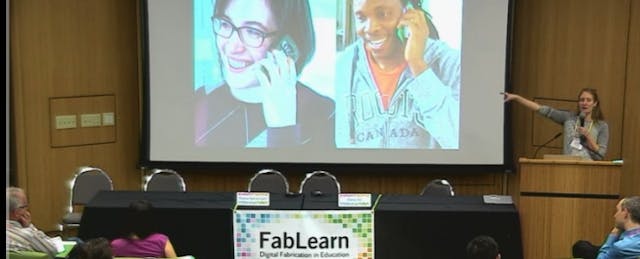The Maker movement may just have discovered that it’s easier to make a robot than to make everyone happy.
At the third annual FabLearn conference at Stanford University, plenty of people talked about the Maker movement’s place in schools and communities. As schools around the world start Makerspaces, educators say they’re trying to reach a broad swath of students: an educator panel including Aaron Vanderwerff, the Creativity Lab Coordinator at Lighthouse Community Charter School who shared how his school has brought the Maker movement to mostly low-income students of color. Emilyn Green from Community Science Workshop Network shared how her organization offers Makers activities to community members in sites like Fresno and Watsonville.
But it wasn’t until the final keynote by Dr. Leah Buechley, a former associate professor at MIT, that the equity conversation stopped being polite and took a critical turn.
“The Maker movement has grown large enough and influential enough that it’s time to turn a critical eye to the culture of the community, what we want it to be and what it really is,” declared Buechley.
She then led the crowd through a rousing--and controversial--presentation on the shortcomings of the Maker movement and how it is been branded within the education community.
In an analysis of every MAKE magazine cover since the first issue in 2005--36 in all--Buechley found that the photos portrayed a “very narrow definition” of Maker activities. The themes have skewed heavily towards electronics, which have been featured on 53% of covers, followed by vehicles (31%), robots (22%), rockets (8%), and music (5%).
What’s missing, she said, are examples from the world of ceramics, costume-engineering, and weaving. She pleaded with the audience to reach out to a more diverse group of makers and include all types of kids. “You gotta do more than robots,” she said.
The most striking statistics Buechley shared focused on the race and gender of the Makers on its covers. Of the 40 people featured, she found that 85% have been men and boys--and none were people of color. The current editorial staff has a similar ratio--87% men, and also no people of color.
“Are you serious!? MAKE, you can do better. It’s your responsibility to do better,” Buechley exclaimed. The audience applauded.
Founded in 2005, the quarterly MAKE Magazine has championed the cause of learning by doing. Led by Dale Dougherty, Maker Media has been the driver for hundreds of Maker events, Makerspaces and Young Makers programs across the country. In 2012, it was a founding sponsor of Maker Education Initiative, which supports bringing Maker activities to schools and communities through workshops, Maker Corps, and Maker VISTA Project
While the Maker Education Initiative is a non-profit spin-off of Maker Media, the fact that they share the same branding is an issue for Buechley. The publication’s “cultural tunnel vision is OK for an inconsequential subculture,” she says. But she has profound reservations when that initiative promises to reach every child. “If you were a different brand, you wouldn’t have to answer to your parent company’s issues,” she says.
In the audience was Paloma Garcia-Lopez, executive director of Maker Education Initiative.
Garcia-Lopez publicly took issue with Buechley’s comments during the question-and-answer section of the presentation.
“It is a gross distortion to paint MAKE as responsible for all of this when we live in a white-male dominated society,” Garcia-Lopez said. Magazine covers notwithstanding, MAKE magazine “has inspired over 100 Maker Faires across the country...As far as social responsibility, the company does bus in 2,000 kids a year to Maker Faire in the Bay Area,” she said.
In a follow up email to EdSurge, Garcia-Lopez stressed that “diversifying the makeup of Makers, the movement, youth who have access, and the pipeline of professionals in STEM and the arts is what Maker Ed is all about.” This past summer, the Maker Ed Initiative trained 108 corps members to work with youth and to spread the maker movement--half of them were female.
To make good, Buechley suggested the magazine include projects that appeal to and are more accessible to a broader audience, including women and different cultures.
“It wouldn’t be hard to make the magazine a more diverse, showcasing vehicle and I think they have a responsibility to do that,” Buechley asserted. Adding diversity, she said, will be key for the Maker community to build broader trust.
Editor’s Note: Dale Dougherty is an investor in EdSurge.


